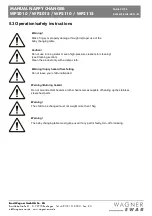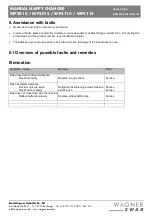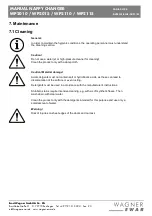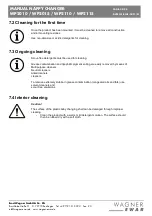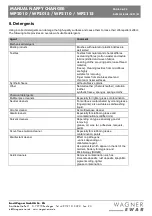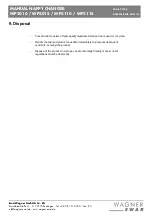
Ernst Wagner GmbH & Co. KG
Ernst-Abbe-Straße 21 · D - 72770 Reutlingen Tel. +49 7121 515
39-0 · Fax: -20
info@wagner-ewar.de · www.wagner-ewar.de
MANUAL NAPPY CHANGER
PAGE: 26/28
WP2010 / WP2015 / WP2110 / WP2115
DATE OF ISSUE: 2021/01
8. Detergents
Using incorrect detergents can damage the high-quality surfaces and cause them to loose their dirt-repellent effect.
The following table provides an overview of suitable detergents.
Agent
Comment
Mechanical detergent
Bristle products
Brushes with natural or plastic bristles are
well suited
Textiles
Textiles from natural and chemical fibres
as cleaning fibres (cotton waste) and textile
fabrics (knitted and woven fabrics,
cleaning cloths, scouring pads, loose thread
material,
(fleece). Cleaning textiles from microfibres
are highly
suitable for removing
finger marks from stainless steel and
chromium nickel surfaces.
Synthetic fleece
without abrasive grains.
Other
Natural leather (chamois leather), imitation
leather,
synthetic fleece, sponges, sponge cloths
Chemical detergents
Multipurpose cleaners
Especially for lighter grease contamination
Neutral cleaners
For surfaces contaminated by oil and grease
(fingerprints); also suitable as dishwashing
liquid.
Alcohol cleaner
As multipurpose cleaner
Alkali cleaners
Especially for stubborn grease and
oil contamination (solidified oils)
Solvent cleaners
Depending on type, especially good at
removing:
grease, oil, wax, tar, adhesives, lacquers,
paints.
Scour-free emulsion cleaner
Especially for stubborn grease
contamination, paints
Disinfectant cleaner
Effect on pathogens
- varies depending on
disinfectant agent.
Use products which appear in the list of the
German Society for Hygiene and
Microbiology (DHGM).
Acidic cleaners
Removes contamination such as
limescale deposits, rust deposits, lipophillic
pigment soiling, lighter
grease contamination.











